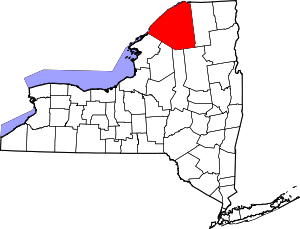Waddington (village), New York
| Waddington, New York | |
|---|---|
| Village | |
 Waddington, New York Location within the state of New York | |
| Coordinates: 44°51′50″N 75°11′49″W / 44.86389°N 75.19694°WCoordinates: 44°51′50″N 75°11′49″W / 44.86389°N 75.19694°W | |
| Country | United States |
| State | New York |
| County | St. Lawrence |
| Area | |
| • Total | 2.4 sq mi (6.2 km2) |
| • Land | 2.2 sq mi (5.6 km2) |
| • Water | 0.2 sq mi (0.5 km2) |
| Elevation | 272 ft (83 m) |
| Population (2010) | |
| • Total | 972 |
| Time zone | Eastern (EST) (UTC-5) |
| • Summer (DST) | EDT (UTC-4) |
| FIPS code | 36-77728 |
| GNIS feature ID | 0977173 |
Waddington is a village located in the Town of Waddington in St. Lawrence County, New York. The population was 972 at the 2010 census. The village is named after Joshua Waddington.
The Village of Waddington is at the northern edge of the town and is north of Canton.
History
The first settlers arrived around 1798.
The village was originally called "Hamilton" (after Alexander Hamilton), but was changed to Waddington in 1818. Joshua Waddington was a friend of Hamilton and one of the original landowners. The village was incorporated in 1839. When the Town of Waddington was formed afterwards, it adopted the name of the village.
During the construction of the St. Lawrence Seaway part of the village needed to be relocated and some of the old industrial area was destroyed.
The Waddington Historic District was listed on the National Register of Historic Places in 1992.[1]
Geography
According to the United States Census Bureau, the village has a total area of 2.4 square miles (6.2 km²), of which, 2.2 square miles (5.6 km²) of it is land and 0.2 square miles (0.5 km²) of it (8.82%) is water.
The village is located near the St. Lawrence River and the international border with Canada. The village fronts on Ogden Island in the St. Lawrence River.
Waddington is at the junctions of New York State Route 37 and New York State Route 345. County Road 44 serves the village from the southeast.
Demographics
| Historical population | |||
|---|---|---|---|
| Census | Pop. | %± | |
| 1860 | 789 | — | |
| 1870 | 710 | −10.0% | |
| 1880 | 977 | 37.6% | |
| 1890 | 900 | −7.9% | |
| 1900 | 757 | −15.9% | |
| 1910 | 731 | −3.4% | |
| 1920 | 702 | −4.0% | |
| 1930 | 679 | −3.3% | |
| 1940 | 671 | −1.2% | |
| 1950 | 819 | 22.1% | |
| 1960 | 921 | 12.5% | |
| 1970 | 955 | 3.7% | |
| 1980 | 980 | 2.6% | |
| 1990 | 944 | −3.7% | |
| 2000 | 923 | −2.2% | |
| 2010 | 972 | 5.3% | |
| Est. 2015 | 968 | [2] | −0.4% |
As of the census[4] of 2000, there were 923 people, 405 households, and 259 families residing in the village. The population density was 425.3 people per square mile (164.2/km²). There were 452 housing units at an average density of 208.3 per square mile (80.4/km²). The racial makeup of the village was 99.13% White, 0.33% Native American, 0.11% from other races, and 0.43% from two or more races. Hispanic or Latino of any race were 0.22% of the population.
There were 405 households out of which 21.7% had children under the age of 18 living with them, 53.8% were married couples living together, 7.4% had a female householder with no husband present, and 36.0% were non-families. 31.1% of all households were made up of individuals and 15.3% had someone living alone who was 65 years of age or older. The average household size was 2.26 and the average family size was 2.79.
In the village the population was spread out with 18.2% under the age of 18, 7.2% from 18 to 24, 23.4% from 25 to 44, 30.8% from 45 to 64, and 20.5% who were 65 years of age or older. The median age was 46 years. For every 100 females there were 93.1 males. For every 100 females age 18 and over, there were 89.2 males.
The median income for a household in the village was $39,615, and the median income for a family was $46,389. Males had a median income of $39,583 versus $24,773 for females. The per capita income for the village was $22,568. About 5.8% of families and 11.3% of the population were below the poverty line, including 16.2% of those under age 18 and 6.8% of those age 65 or over.
References
- ↑ National Park Service (2009-03-13). "National Register Information System". National Register of Historic Places. National Park Service.
- ↑ "Annual Estimates of the Resident Population for Incorporated Places: April 1, 2010 to July 1, 2015". Retrieved July 2, 2016.
- ↑ "Census of Population and Housing". Census.gov. Retrieved June 4, 2015.
- ↑ "American FactFinder". United States Census Bureau. Retrieved 2008-01-31.
